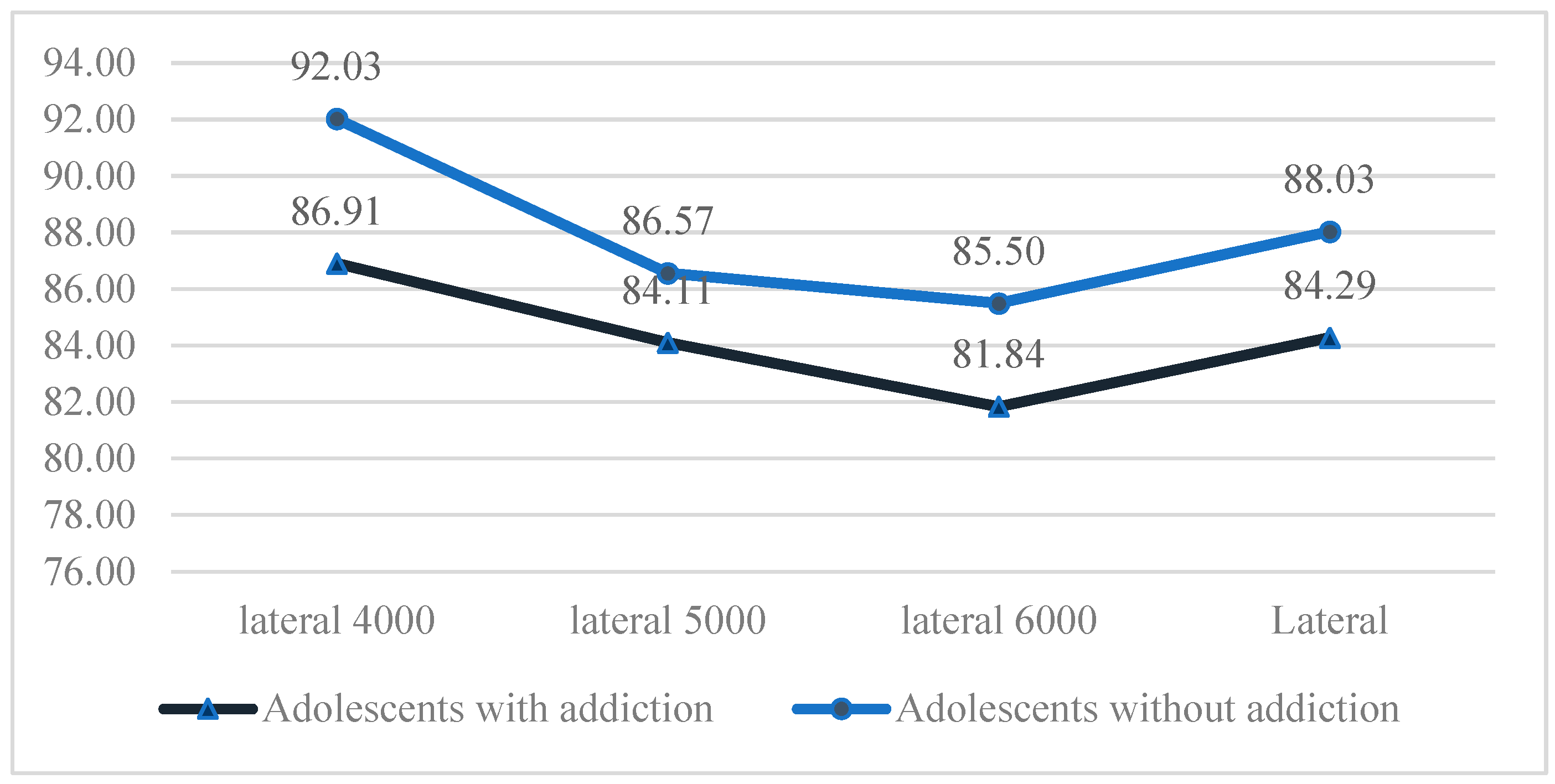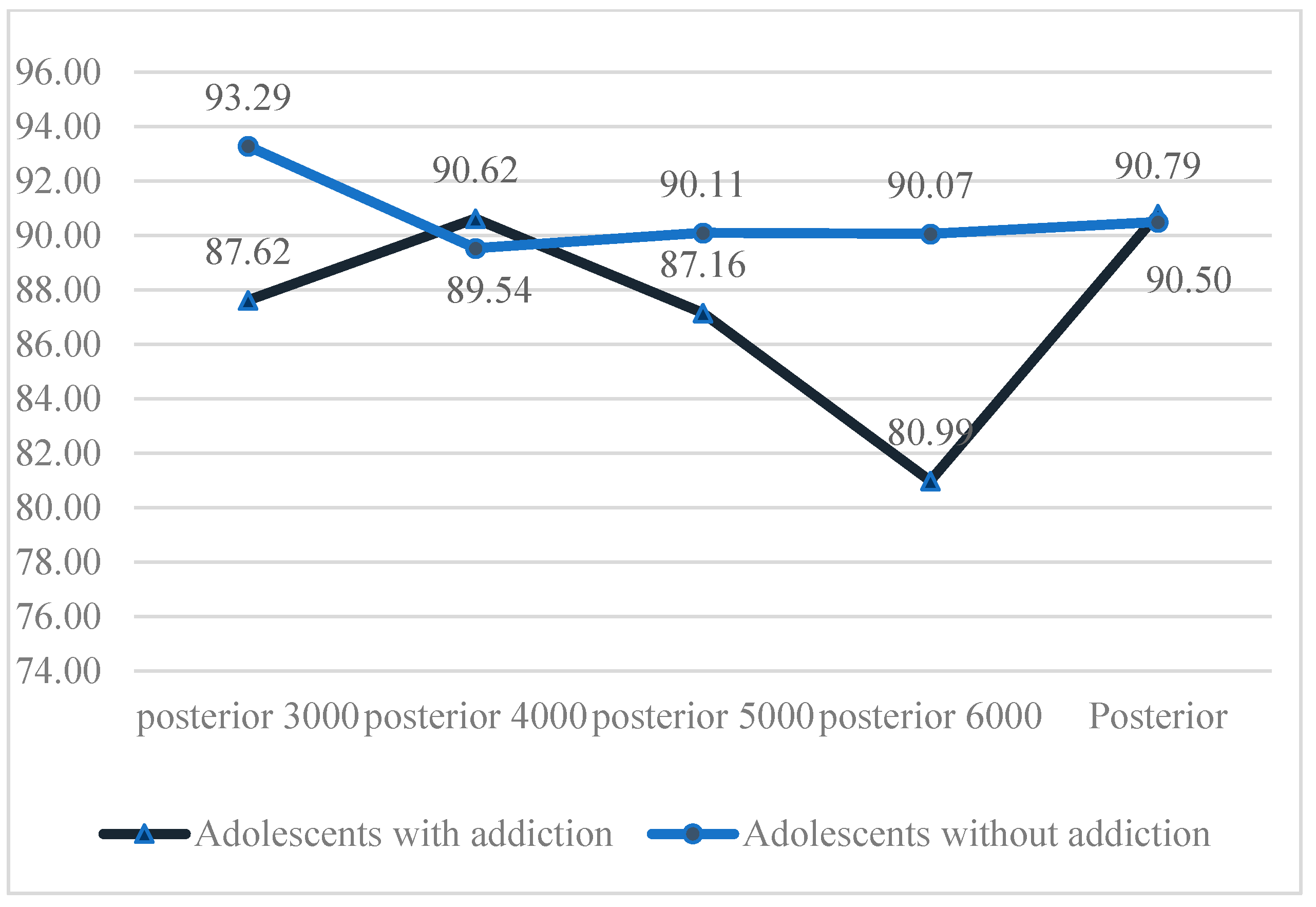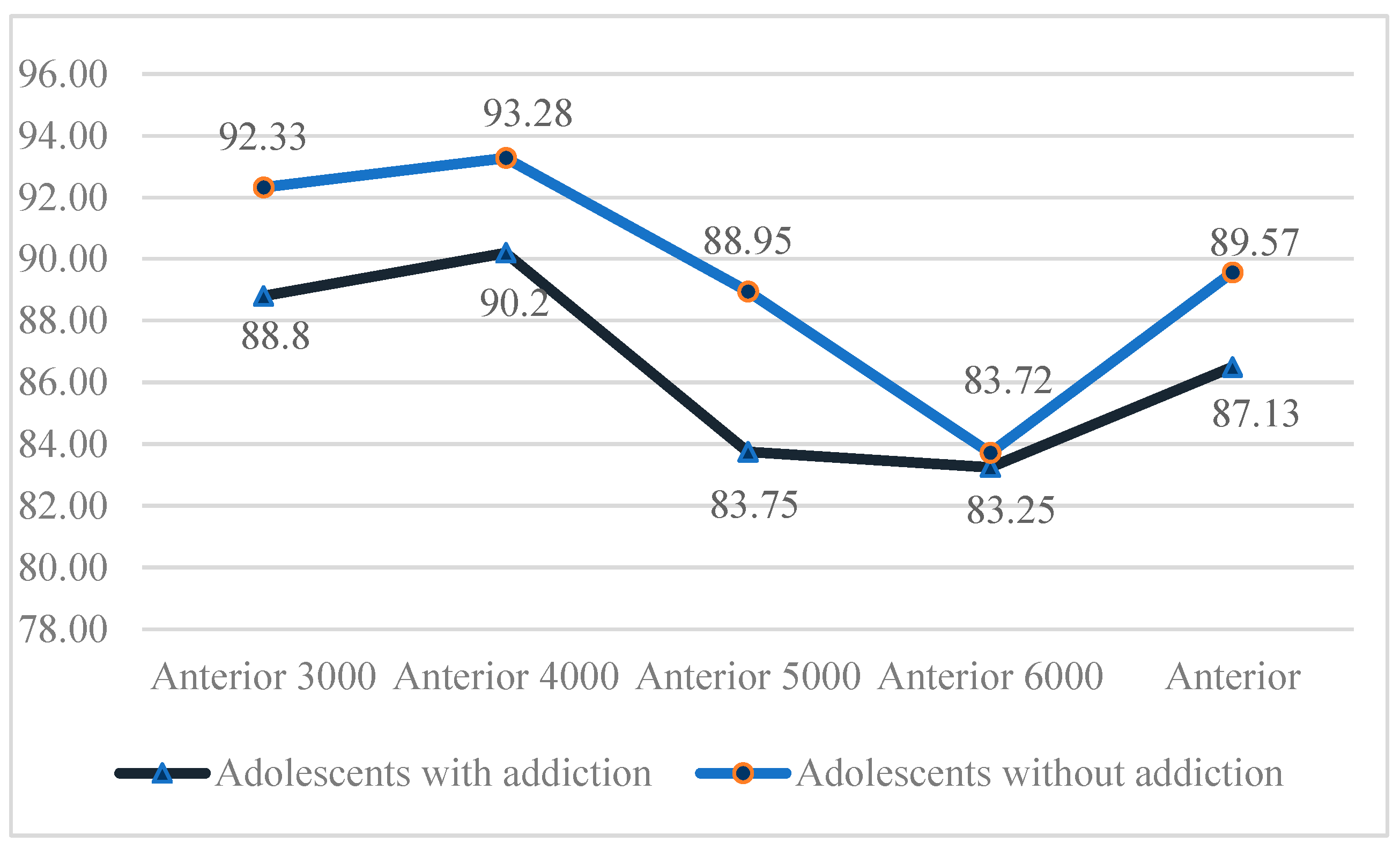The Relationship Between the Functional Head Impulse Test (F-HIT) and Digital Gaming Addiction in Adolescents
Abstract
1. Introduction
2. Materials and Methods
2.1. Research Design
2.2. Study Group
2.3. Data Collection Tools
2.3.1. Digital Game Addiction Scale (DGAS)
2.3.2. Functional Head Impulse Test (F-HIT)
2.4. Ethical Principles of Research
2.5. Data Analysis
3. Results
4. Discussion
5. Conclusions
Author Contributions
Funding
Institutional Review Board Statement
Informed Consent Statement
Data Availability Statement
Acknowledgments
Conflicts of Interest
Abbreviations
| %CA | Percentage of Correct Answers |
| DGAS | Digital Game Addiction Scale |
| f-HIT | Functional Head Impulse Test |
| SPSS | Statistical Program for Social Sciences |
| VOR | Vestibulo-ocular Reflex |
References
- Arslan, A. Ortaöğretim öğrencilerinin dijital bağımlılık düzeylerinin çeşitli değişkenler açısından incelenmesi: Sivas ili örneği. Gazi Eğit. Bilim. Derg. 2019, 5, 63–80. [Google Scholar]
- Dursun, A.; Çapan, B.E. Ergenlerde dijital oyun bağımlılığı ve psikolojik ihtiyaçlar. İnönü Üniv. Eğit. Fak. Derg. 2018, 19, 128–140. [Google Scholar] [CrossRef]
- Karabulut, B. Bilgi toplumu çağinda dijital yerliler, göçmenler ve melezler. Pamukkale Üniv. Sos. Bil. Ens. Derg. 2015, 21, 11–23. [Google Scholar]
- Sparrow, P.; Griffiths, M. Crime and IT: Hacking and pornography on the internet. Prob. J. 1997, 44, 144–147. [Google Scholar]
- Cordes, C.; Miller, E. Fool’s Gold: A Critical Look at Computers in Childhood. 2000. Available online: http://www.allianceforchildhood.net/projects/computers/computers_reports.htm (accessed on 5 June 2023).
- İşçibaşı, Y. Bilgisayar, İnternet ve video oyunları arasında çocuklar. Selçuk İletişim Derg. 2011, 7, 122–130. [Google Scholar]
- Palmer, S. Toxic Childhood: How the Modern World is Damaging Our Children and What We Can Do About It; Orion Books: London, UK, 2006; pp. 1–384. [Google Scholar]
- Plowman, L.; McPake, J.; Stephen, C. The technologisation of childhood? Young children and technology in the home. Child. Soc. 2010, 24, 63–74. [Google Scholar] [CrossRef]
- Brown, A. Council on Communications and Media. Media use by children younger than 2 years. Pediatrics 2011, 128, 1040–1045. [Google Scholar] [CrossRef] [PubMed]
- Fan, J.; McCandliss, B.D.; Fossella, J.; Flombaum, J.I.; Posner, M.I. The activation of attentional networks. Neuroimage 2005, 26, 471–479. [Google Scholar] [CrossRef]
- Nathanson, A.I.; Sharp, M.L.; Aladé, F.; Rasmussen, E.E.; Christy, K. The relation between television exposure and theory of mind among preschoolers. J. Commun. 2013, 63, 1088–1108. [Google Scholar] [CrossRef]
- Emekci, T.; Erbek, H.S. The relationship between functional head impulse test and age in healthy individuals. J. Vestib. Res. 2022, 32, 123–134. [Google Scholar] [CrossRef]
- Nandi, R.; Luxon, L.M. Development and assessment of the vestibular system. Int. J. Audiol. 2008, 47, 566–577. [Google Scholar] [CrossRef]
- Tóth, M.; Csillag, A. The Organ of Hearing and Equilibrium. In Atlas of the Sensory Organs; Csillag, A., Ed.; Humana Press: Totowa, NJ, USA, 2005; pp. 1–83. [Google Scholar]
- Böhler, A.; Mandalà, M.; Ramat, S. A software program for the Head Impulse Testing Device (HITD). In Proceedings of the 2010 Annual International Conference of the IEEE Engineering in Medicine and Biology, Buenos Aires, Argentina, 31 August–4 September 2010; Institute of Electrical and Electronics Engineers (IEEE): Piscataway, NJ, USA, 2010; Volume 2010, pp. 6615–6618. [Google Scholar]
- Ramat, S.; Colnaghi, S.; Boehler, A.; Astore, S.; Falco, P.; Mandalà, M.; Nuti, D.; Colagiorgio, P.; Versino, M. A device for the functional evaluation of the VOR in clinical settings. Front. Neurol. 2012, 3, 21800. [Google Scholar] [CrossRef] [PubMed]
- Versino, M.; Colagiorgio, P.; Sacco, S.; Colnaghi, S.; Quaglieri, S.; Manfrin, M.; Benazzo, M.; Moglia, A.; Ramat, S. Reading while moving: The functional assessment of VOR. J. Vestib. Res. 2014, 24, 459–464. [Google Scholar] [CrossRef]
- Lemmens, J.S.; Valkenburg, P.M.; Peter, J. Development and validation of a game addiction scale for adolescents. Media Psychol. 2009, 12, 77–95. [Google Scholar] [CrossRef]
- Yalçın Irmak, A.; Erdoğan, S. Dijital Oyun Bağımlılığı Ölçeği Türkçe formunun geçerliliği ve güvenilirliği. Anatol. J. Psychiatry 2015, 16, 10–18. [Google Scholar]
- Alpar, C. Spor Sağlık ve Eğitim Bilimlerinden Örneklerle Uygulamalı Istatistik ve Geçerlik Güvenirlik; Detay Publishing: Ankara, Türkiye, 2016; pp. 1–744. [Google Scholar]
- Cohen, J. Statistical Power Analysis for the Behavioral Sciences; Lawrence Erlbaum Associates, Publishers: Mahwah, NJ, USA, 1998. [Google Scholar]
- Ellialtıoğlu, F.M. Okul Öncesi Dönemde Oyun ve Örnekleri; YA-PA Yayınları: İstanbul, Türkiye, 2005; pp. 1–336. [Google Scholar]
- Hazar, K.; Özpolat, Z.; Hazar, Z. Ortaokul öğrencilerinin dijital oyun bağımlılığı düzeylerinin çeşitli değişkenlere göre incelenmesi (Niğde ili örneği). Spormetre 2020, 18, 225–234. [Google Scholar]
- Göldağ, B. Lise Öğrencilerinin dijital oyun bağımlılık düzeylerinin demografik özelliklerine göre incelenmesi. YYÜ Eğit. Fak. Derg. 2018, 15, 1287–1315. [Google Scholar]
- Şimşek, E.; Karakuş Yılmaz, T. Türkiye’de yürütülen dijital oyun bağımlılığı çalışmalarındaki yöntem ve sonuçların sistematik incelemesi. Kastamonu Educ. J. 2020, 28, 1851–1866. [Google Scholar]
- Türkiye İstatistik Kurumu (TUİK). Çocuklarda Bilişim Teknolojileri Kullanım Araştırması. 2021. Available online: https://data.tuik.gov.tr/Bulten/Index?p=Cocuklarda-Bilisim-Teknolojileri-Kullanim-Arastirmasi-2021-41132 (accessed on 12 November 2023).
- Aras, E. Ortaokul öğrencilerinin Dijital Oyun Bağımlılığının Yalnızlık ve Benlik Saygısı ARASINDAKI Ilişkisi ve Dijital Oyun Bağimliliğinin Çeşitli Demografikler Açısından Incelenmesi. Master’s Thesis, Bahçeşehir Üniversitesi, İstanbul, Türkiye, 2021. [Google Scholar]
- We Are Social. Global Digital Report. 2022. Available online: https://wearesocial.com/uk/blog/2022/07/the-global-state-of-digital-in-july-2022/ (accessed on 10 July 2023).
- Gökel, Ö. Teknoloji bağımlılığının çeşitli yaş gruplarındaki çocuklara etkileri hakkındaki ebeveyn görüşleri. Kıbrıs Türk Psikiy. Psikol. Derg. 2020, 2, 41–47. [Google Scholar]
- Pınarbaşı Erkişi, E.; Sağlam, M. Ergenlerde İnternet bağımlılığının öz-yeterliğe etkisinin incelenmesi. İnönü Üniv. Sağlık Hiz. Meslek Yüksekok. Derg. 2020, 8, 46–71. [Google Scholar] [CrossRef]
- Gámez-Guadix, M.; Celvete, E.; Orue, I.; Las Hayas, C. Problematic Internet use and problematic alcohol use from the cognitive–behavioral model: A longitudinal study among adolescents. Addict. Behav. 2015, 40, 109–114. [Google Scholar] [CrossRef]
- Drummond, A.; Sauer, J.D. Video-games do not negatively impact adolescent academic performance in science, mathematics or reading. PLoS ONE 2014, 9, e87943. [Google Scholar] [CrossRef]
- Delebe, A. Ortaokul Öğrencilerinde Dijital Oyun Bağımlılığı ile Bazı Fiziksel Parametreler ve Akademik Başarı Durumları Arasındaki Ilişkinin Incelenmesi. Master’s Thesis, Niğde Ömer Halisdemir University, Niğde, Türkiye, 2020. [Google Scholar]
- Gentile, D. Pathological video-game use among youth ages 8 to 18: A national study. Psychol. Sci. 2009, 20, 594–602. [Google Scholar] [CrossRef]
- Douglas, A.C.; Mills, J.E.; Niang, M.; Stepchenkova, S.; Byun, S.; Ruffini, C.; Lee, S.K.; Loutfi, J.; Lee, J.K.; Attalah, M.; et al. Internet addiction: Meta-synthesis of qualitative research for the decade 1996–2006. Comput. Human Behav. 2008, 24, 3027–3044. [Google Scholar] [CrossRef]
- Gedik Toker, Ö.; Elibol, N.T.; Erentürk, Ö.; Erdem, S.; Behmen, M.B.; Bal, N. Effect of digital screen usage on the visual-vestibular system interaction. Egypt. J. Otolaryngol. 2023, 39, 140. [Google Scholar] [CrossRef]
- Söylemez, E.; Dağ, M.; Ilgaz, A.; Korkmaz, B.; Topçuoğlu, Ü.; Koç, A.D.; Ensari, S. Excessive smartphone use increases self-reported auditory and vestibular symptoms. Wien. Klin. Wochenschr. 2024, 1–7. [Google Scholar] [CrossRef] [PubMed]
- Mustafaoğlu, R.; Yasacı, Z. Dijital oyun oynamanın çocukların ruhsal ve fiziksel sağlığı üzerine olumsuz etkileri. Bağımlılık Derg. 2018, 19, 51–58. [Google Scholar]
- Pandya, A.; Lodha, P. Social connectedness, excessive screen time during covid-19 and mental health: A review of current Evidence. Front. Hum Dyn. 2021, 3, 684137. [Google Scholar] [CrossRef]
- Toran, M.; Ulusoy, Z.; Aydın, B.; Deveci, T.; Akbulut, A. Çocukların dijital oyun kullanımına ilişkin annelerin görüşlerinin değerlendirilmesi. Kastamonu Educ. J. 2016, 24, 2263–2278. [Google Scholar]
- Gaggi, O.; Palazzi, C.E.; Ciman, M.; Galiazzo, G.; Franceschini, S.; Ruffino, M.; Gori, S.; Facoetti, A. Serious games for early identification of developmental dyslexia. Comput. Entertain. 2017, 15, 1–24. [Google Scholar] [CrossRef]



| Variable | Game Addict | Non-Game Addict | Test Value | p Value | ||
|---|---|---|---|---|---|---|
| Mean ± SD M (Min–Max) | Cronbach α | Mean ± SD M (Min–Max) | Cronbach α | |||
| Digital Game Addiction Scale (DGAS) Score | 26.34 ± 5.16 26 (17–35) | 0.785 | 12.16 ± 3.99 11.5 (7–21) | 0.714 | 16.500 | 0.001 * |
| Age | Mean ± SD M (Min–Max) | Mean ± SD M (Min–Max) | Test Value | p Value | ||
| 15.63 ± 1.05 16 (14–17) | 15,5 ± 1.16 15.5 (14–17) | 675,000 | 0.610 | |||
| Variable | Game Addict | Non-Game Addict | Total | χ2 Test | p a Value | |
|---|---|---|---|---|---|---|
| Number (%) | ||||||
| Weekly Game Play Time (Days) | 1 day | (-) | 4 (%10.5) | 4 (%5.3) | 0.486 | 0.001 * |
| 1–3 days | (-) | 10 (%26.3) | 10 (%13.2) | |||
| 3–5 days | 6 (%15.8) | 6 (%15.8) | 12 (%15.8) | |||
| 7 days | 32 (%84.2) | 18 (%47.4) | 50 (%65.8) | |||
| Daily Game Play Time (Hours) | Less than 1 h | (-) | 8 (%21.1) | 8 (%10.5) | 0.660 | 0.001 * |
| 1–3 h | 6 (%15.8) | 22 (%57.9) | 28 (%36.8) | |||
| 4–6 h | 24 (%63.2) | 8 (%21.1) | 32 (%42.1) | |||
| More than 7 h | 8 (%21.1) | (-) | 8 (%10.5) | |||
| Gaming Device | Smartphone | 29 (%76.3) | 34 (%89.5) | 63 (%82.9) | 0.205 | 0.201 |
| Tablet | 4 (%10.5) | 3 (%7.9) | 7 (%9.2) | |||
| Computer | 5 (%13.2) | 1 (%2.6) | 6 (%7.9) | |||
| Variable | Game Addict | Non-Game Addict | Test Value | p b Value | ||
| Mean ± SD M (Min–Max) | ||||||
| Average GPA | 55.39 ± 9.36 55.5 (39.38–74.11) | 66.36 ± 12.41 61.5 (51–91.7) | 375,000 | 0.001 * | ||
| Game Play Time (Years) | 5.66 ± 2.13 5 (3–13) | 2.47 ± 1.13 3 (1–5) | 90,500 | 0.001 * | ||
| Variable | Game Addict | Non-Game Addict | Test Value | p Value | Cohen’s d |
|---|---|---|---|---|---|
| Mean ± SD M (Min–Max) | Mean ± SD M (Min–Max) | ||||
| Lateral SSC 4000°/s2 %CA | 86.91 ± 11.96 80 (60–100) | 92.03 ± 12.71 100 (50–100) | 2240.000 | 0.008 * | 0.41 |
| Lateral SSC 5000°/s2 %CA | 84.11 ± 11.62 82.5 (50–100) | 86.57 ± 14.1 88 (50–100) | 2495.000 | 0.138 | 0.19 |
| Lateral SSC 6000°/s2 %CA | 81.84 ± 15.72 80 (50–100) | 85.5 ± 15.73 84 (50–100) | 2603.000 | 0.263 | 0.23 |
| Lateral SSC Total %CA | 84.29 ± 8.97 83.33 (60–100) | 88.03 ± 9.6 90 (61.67–100) | 2180.500 | 0.009 * | 0.40 |
| Posterior SSC 3000°/s2 %CA | 87.62 ± 16.49 100 (50–100) | 93.29 ± 13.01 100 (50–100) | 2398.000 | 0.027 * | 0.38 |
| Posterior SSC 4000°/s2 %CA | 90.62 ± 12.27 100 (57–100) | 89.54 ± 16.09 100 (10–100) | 2885.000 | 0.990 | 0.07 |
| Posterior 5000°/s2 %CA | 87.16 ± 16.14 100 (50–100) | 90.11 ± 12.39 100 (67–100) | 2687.000 | 0.415 | 0.20 |
| Posterior SSC 6000°/s2 %CA | 80.99 ± 17.82 75 (33–100) | 90.07 ± 15.29 100 (50–100) | 2109.000 | 0.001 * | 0.54 |
| Posterior SSC Total %CA | 90.79 ± 7.5 91.75 (71.4–100) | 90.5 ± 7.77 91.85 (72.2–100) | 2820.500 | 0.802 | 0.03 |
| Anterior SSC 3000°/s2 %CA | 88.8 ± 15.19 100 (50–100) | 92.33 ± 13.64 100 (50–100) | 2569.000 | 0.153 | 0.24 |
| Anterior SSC 4000°/s2 %CA | 90.2 ± 13.09 100 (50–100) | 93.28 ± 11.56 100 (67–100) | 2537.000 | 0.126 | 0.24 |
| Anterior SSC 5000°/s2 %CA | 83.75 ± 16.66 83 (33–100) | 88.95 ± 14.31 100 (50–100) | 2367.500 | 0.039 * | 0.33 |
| Anterior SSC 6000°/s2 %CA | 83.25 ± 19.42 100 (33–100) | 83.72 ± 18.64 100 (50–100) | 2879.000 | 0.971 | 0.02 |
| Anterior SSC Total %CA | 86.5 ± 10.97 87.13 (67–100) | 89.57 ± 8.93 91.75 (72.25–100) | 2449.500 | 0.103 | 0.30 |
Disclaimer/Publisher’s Note: The statements, opinions and data contained in all publications are solely those of the individual author(s) and contributor(s) and not of MDPI and/or the editor(s). MDPI and/or the editor(s) disclaim responsibility for any injury to people or property resulting from any ideas, methods, instructions or products referred to in the content. |
© 2025 by the authors. Licensee MDPI, Basel, Switzerland. This article is an open access article distributed under the terms and conditions of the Creative Commons Attribution (CC BY) license (https://creativecommons.org/licenses/by/4.0/).
Share and Cite
Cengiz, D.U.; Çolak, S.C.; Kay, M.A.; Kurtcu, B.; Sağlam, M.; Duran, M.; Çelik, O.T. The Relationship Between the Functional Head Impulse Test (F-HIT) and Digital Gaming Addiction in Adolescents. Children 2025, 12, 837. https://doi.org/10.3390/children12070837
Cengiz DU, Çolak SC, Kay MA, Kurtcu B, Sağlam M, Duran M, Çelik OT. The Relationship Between the Functional Head Impulse Test (F-HIT) and Digital Gaming Addiction in Adolescents. Children. 2025; 12(7):837. https://doi.org/10.3390/children12070837
Chicago/Turabian StyleCengiz, Deniz Uğur, Sanem Can Çolak, Mehmet Akif Kay, Büşra Kurtcu, Mehmet Sağlam, Munise Duran, and Osman Tayyar Çelik. 2025. "The Relationship Between the Functional Head Impulse Test (F-HIT) and Digital Gaming Addiction in Adolescents" Children 12, no. 7: 837. https://doi.org/10.3390/children12070837
APA StyleCengiz, D. U., Çolak, S. C., Kay, M. A., Kurtcu, B., Sağlam, M., Duran, M., & Çelik, O. T. (2025). The Relationship Between the Functional Head Impulse Test (F-HIT) and Digital Gaming Addiction in Adolescents. Children, 12(7), 837. https://doi.org/10.3390/children12070837






